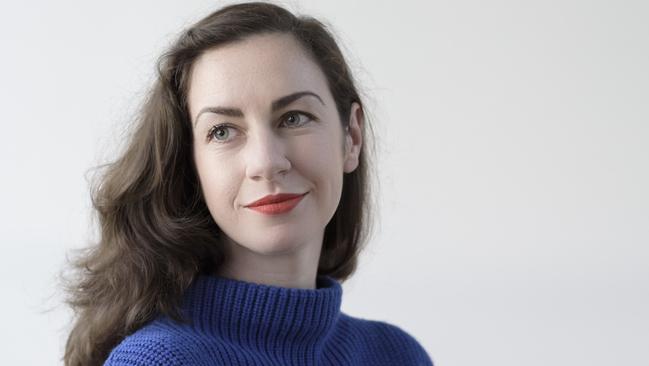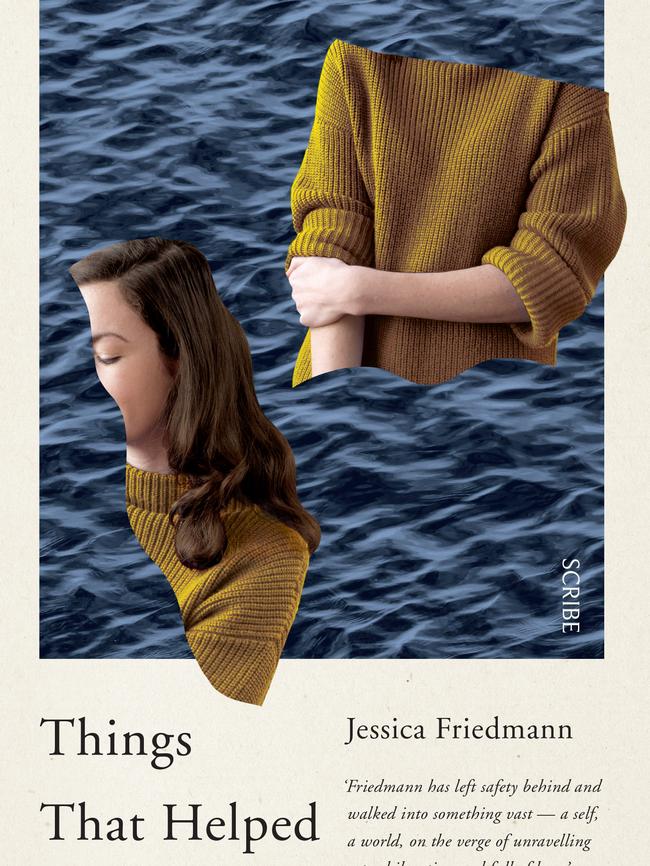Things That Helped: Friedmann goes into the depths of despair and back
From the opening essay the reader is plunged into the depths of Jessica Friedmann’s despair.

Jessica Friedmann’s broken figure hovers over a choppy sea on the striking cover of Things That Helped. And right from the opening essay, the reader is plunged into the depths of Friedmann’s despair. This deeply affective debut book chronicles the birth of her first son and the postnatal depression that nearly sent her under.
Ecofeminism is a through line and, in what becomes an overarching theme of the earth’s healing powers, Friedmann opens by describing a particularly dark time in her life when she longed to abandon her responsibilities as a wife and mother, and drown herself in the river near her home in Melbourne’s western suburbs: “I thought of the water as I listened out for the baby’s breath, in and out, lightly broken.”

The personal essay is a fertile genre and Friedmann’s use of the essay structure, over a more linear memoir style, is worth noting. In North America, especially, attention surrounds essayists such as Maggie Nelson and Eula Biss who similarly meld memoir and critical theory to explore topics that also appear in Friedmann’s book: gender, class and motherhood.
Closer to home, Fiona Wright’s 2015 essay collection Small Acts of Disappearance makes an interesting companion study as she and Friedmann use the essay structure to work through their diagnosis (in Wright’s case, anorexia nervosa). Like Wright, Friedmann doesn’t offer a conventional recovery narrative; both authors concede life is too messy for that. Writing, however, is one way to gain control, or as Wright says in her book, to “proscribe, and prescribe a meaning” to illness.
Writing is also a way of externalising inward pain. ‘‘What does it mean to look at a work of art?’’ It is a question Friedmann asks throughout this book, as well as being the subtitle of Embodied Visions, an essay by American writer Siri Hustvedt. In considering her own embodied responses to art, Friedmann deconstructs Hustvedt’s essay and attempts to understand how inanimate objects have the power to move her.
It is one of many instances where Friedmann turns to other theorists and creative practitioners to make sense of her state of mind. Where conventional psychiatry fails her, art becomes an experimental form of therapy.
In Friedmann’s world, art is everywhere, and its effects are visceral. Each essay focuses on a discrete thing that helped her through a bad time. Gripped by sadness, she feels joy while applying lipstick, or drinking her favourite pho. When the fog descends and makes it hard to think, she escapes into the pleasing three-act structure of a Hollywood ballet movie. Elsewhere, she finds order in abstract paintings and catharsis in listening to sad music.
Artmaking is also a coping mechanism: she is soothed while working her hands over a loom or when pursuing her primary art form — writing — only to become distraught when illness robs her of the ability to do so.
Despite the heavy subject matter, there’s a determined effort by Friedmann to resist the temptation of self-pity. She reflects on her adolescence, noting that while her Jewish family has its own generational trauma to deal with, life has ultimately been good to her.
“I know walking out over a ledge that there will most likely be somebody there to catch me,” she writes, acknowledging that she is the beneficiary of an inner Melbourne upbringing and a tertiary education.
Such moments point to a self-awareness in her personal essays — a genre that is often criticised for being the opposite. Throughout, she worries about an underlying privilege to her sadness; that her story will be yet another addition to what she labels the “suffering women’s canon”. She writes: “Virginia Woolf, Sylvia Plath, Winona Ryder in Girl Interrupted: the tragic and creative white woman is such a well-known figure that our fragility and need for protection is automatically assumed.”
Through adopting the lens of intersectionality, Friedmann avoids becoming a cliche. She demonstrates a solid understanding of the power structures surrounding motherhood, of which race is one. While depression has a strong physiological root cause, she is aware of the societal factors that also contribute. Despite the buffer of whiteness, she suffers due to the unpaid emotional labour of motherhood and the gendered stigma surrounding depression. Friedmann’s self-awareness is complemented by a grounding in psychoanalysis, but she strikes a good balance between memoir and theory and never lets the latter weigh down her essays. A tightly coiled anger threatens what she jokingly calls her “polished middle-class vocabulary” as she breaks the silence surrounding her illness: “We do not talk about these moments when we dream of running our children under boiling taps or pinching their small noses closed.” She knows she has violated the bounds of acceptable womanhood by having such feelings, and this guilt, this fear of being a “bad mother”, plays on her already fragile mind.
In local publishing, essays that experiment with form and theory, such as Friedmann’s, mainly live at the margins in literary magazines. It is worth noting that Friedmann rose through these ranks as a writer, as well as being a former editor of poetry journal Going Down Swinging. Her style of politicised personal writing is refreshing, and this book is further proof that these cultural institutions are vital in unearthing new, intellectually stimulating voices.
Jessica Friedmann will be a guest of the Sydney Writers Festival, May 22 to 28.
Emily Laidlaw is a writer and editor.
Things That Helped: Essays
By Jessica Friedmann
Scribe, 272pp, $29.99



To join the conversation, please log in. Don't have an account? Register
Join the conversation, you are commenting as Logout